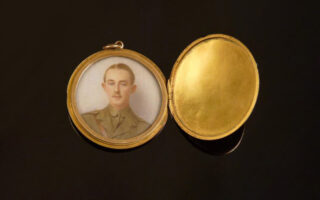Dublin Castle holds a wealth of history and there are many stories both old and new that centre around this OPW site.
On Easter Monday, 24th April 1916 as the independent Irish Republic was being declared from the steps of the General Post Office in Sackville Street (now O’ Connell St.), Dublin, Ireland, a young British army officer was preparing to go on duty.
Lieutenant Guy Vickery Pinfield was twenty-one years old and was a rugby-playing, former student of Cambridge University. He had received his commission as a second lieutenant into the 8th King’s Royal Irish Hussars at the outbreak of war in 1914. A year later he was posted to the 10th Reserve Cavalry Regiment at the Curragh Camp in County Kildare. Born in Bishops Stortford, Hertfordshire in 1895, Vickery Pinfield came from a successful and prosperous family that had made their money through tea plantations in the Indian province of Assam. Like many other young men of the regiment, he was waiting for his orders to move to the front. The conflict had been raging for two years and he was concerned that the war would be over before he got a chance to join in.
On the 24th April 1916, news reached the Curragh camp that a Rebellion had erupted in Dublin city and reinforcements were needed urgently in order to secure military and government buildings. Vickery Pinfield was posted to the city by train and was sent to Dublin Castle.
Shortly before midday, a section from the Irish Citizen Army commanded by Abbey actor, Seán Connolly, occupied City Hall and other strategic positions in the area. An unarmed policeman, James O’ Brien, was shot dead as he attempted to close the gates of Dublin Castle. The guardroom of the complex was rushed by a number of armed Volunteers. From these posts, Connolly’s men kept up a relentless fire against British forces within the Castle. It was imperative that this threat be removed immediately. Vickery Pinfield was ordered to lead an attack with the objective of securing the main gate of the Castle and the guardhouse. Under heavy fire, the platoon moved towards the gate but Vickery Pinfield was shot and fell to the ground mortally wounded. A section of his unit moved forward and laid down some strong covering fire while another group of them managed to pull their dying officer into cover. Francis Sheehy Skeffington, a well-known Dublin pacifist, braved the hail of gunfire to bring aid to the stricken officer, but it was too late. The platoon fell back having suffered one officer killed, another officer wounded while approximately thirty ordinary ranks were wounded.
As the rebellion raged throughout Easter week, those that had fallen were hastily buried in the grounds of the complex. Vickery Pinfield’s body was wrapped in a winding sheet and interred in a temporary grave in the Castle gardens, as were many other British soldiers.
After the Rising, the families of the dead came to the Castle to reclaim the bodies of their loved ones. At the end of that month, those bodies that had not been claimed were reinterred at the British military cemetery at Blackhorse Avenue, Grangegorman. However, the bodies of Vickery Pinfield and another four officers, Godfrey Hunter (26), Algernon Lucas (37), Philip Addison (20) and Basil Worsley-Worswick (35), remained in Dublin Castle, unclaimed. Granite slabs recorded the names, regiments and dates of death of the five officers.
There they remained, as the formal garden slowly succumbed to the elements, over decades of neglect. Their temporary graves were rediscovered by chance in 1962 on what was by that time deemed waste ground. The Commonwealth War Graves Commission made arrangements for the bodies to be exhumed and the remains reburied within Grangegorman cemetery. On the 17th May 1963, the five men were buried with the distinctive Commonwealth War Grave headstones marking out their final resting place.

Despite appearances and what seems like neglect for his body, Vickery Pinfield was not forgotten. Soon after his death in 1916 The Illustrated London News published his photo on their Roll of Honour. His obituary in The Times announced the much loved only son of Mrs P. Russell had been killed in action in Ireland. At Marlborough College his name appears with 742 others who lost their lives during the Great War 1914–1918. His fellow officers erected a plaque to his memory that is located within St. Patrick’s Cathedral in Dublin, the only plaque in the cathedral connected to the Easter Rising. In his home town of Bishops Stortford, his name appears in the local church and town war memorial. His old rugby club at Rosslyn Park also have his name on their memorial. To his family, friends and community Vickery Pinfield was not forgotten, but for the wider world he would have remained another unknown statistic of the Irish Easter Rising if it were not for the recent auction of the locket. This prompted a number of researchers to investigate the story of this young man and why his body was left in the grounds of Dublin castle for so many years.
The 15 carat gold memorial locket sold for £850 and carries his image. It is engraved with the words of the Hussars’ motto “Pristinae Virtutis memores” (The memory of former valour). The officers initials ‘GVP’ and his place and date of death, Dublin April 24th 1916, are also to be found on the locket which his mother wore throughout her life. A letter to her from a brother officer in Pinfield’s regiment may disclose one of the reasons why his body was not removed from the castle and repatriated to England. The officer states that Pinfield’s remains were to be buried within the Castle environs in consecrated ground, a fitting resting place as it was just a few feet from where he fell. It is possible that Pinfield’s mother took solace in this and left the remains of her son where she believed they would be tended to by the military.

To most of the world the 1916 Easter Rising was over-shadowed by events on the Western Front later that year. The Battle of the Somme followed that summer and the 116 British soldiers killed during the insurrection in Dublin city were listed as ‘killed at home’. The British military and government were reluctant to remember soldiers killed in Dublin during the rebellion, as the event had caused some embarrassment.
In Britain, Remembrance Day recalls those British and allied servicemen and women who died in two World Wars. The first of these ceremonies took place on the 11th November 1919. As the years went by, the event was commemorated by a two-minute silence, church services and parades to newly erected memorials. In Ireland these events became controversial with the establishment of the Irish Free State in 1922 and in the years that followed, the memories of the war and those who had fallen became a private recollection for those who had served or who had lost loved ones during the conflict.
Many of the men and women who fought in Dublin city that Spring over 100 years ago have been consigned to dusty annals, a page in an archive or a paragraph in a book. With the passing of time, we are growing ever more distant from one of the most important events in Irish and British history and those from both sides who took part.
The locket that was sold at auction to an unknown Irish bidder had been specifically made to commemorate Guy Vickery Pinfield. Every headstone in a cemetery has a story to tell and Lieutenant Pinfields’ was no exception.
This article first appeared in The Irish Times, May 2013.
About the Author
Paul O’ Brien MA, a military historian and author, works for the Office of Public Works and is currently based at the Royal Hospital, Kilmainham. The author of fifteen books, he has written extensively on the 1916 Rising, the British Army in Ireland and a number of local histories. He lives in Santry, Dublin with his wife, daughter and two cats. Stay up to date with the author at: paulobrienauthor.ie


